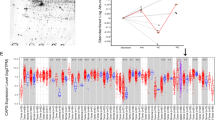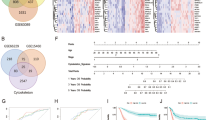Abstract
WAVE3, an actin cytoskeleton remodeling protein overexpressed in many kinds of cancers, has been associated with a lot of metastatic diseases. However, the role and mechanisms of the high expression of WAVE3 in human gastric cancer has not been fully elucidated. Here we demonstrated that WAVE3 was expressed in all six kinds of gastric-cancer cell lines: BGC-823, SGC-7901, AGS, MGC803, MKN28 and MKN45. Furthermore, a correlation was found between aggressiveness of these cell lines and expression of WAVE3. Next, we investigated the role of WAVE3 in SGC-7901 cells and found that upregulating WAVE3 could promote the migration, invasion and proliferation of SGC-7901 cells in vitro. It has been reported that WAVE3 could induce cancer invasion and metastasis by participating epithelial–mesenchymal transition (EMT). However, the mechanisms are not entirely clear. In this study we showed that elevated WAVE3 levels could induce EMT in SGC-7901 cells by dampening the expression of E-cadherin while increasing the expression of vimentin. Elevated WAVE3 levels could also improve the expression of transcription factor Snail. In addition, downregulating Snail could particularly reduce EMT and the metastasis, invasion and proliferation activity in SGC-7901 cells elevated by overexpression of WAVE3. Taken together, we demonstrated that WAVE3 promoted gastric-cancer-cells migration and invasion by taking part in EMT via upregulation of Snail. WAVE3 could be a useful target for gastric-cancer prevention and therapy.
This is a preview of subscription content, access via your institution
Access options
Subscribe to this journal
Receive 12 print issues and online access
$259.00 per year
only $21.58 per issue
Buy this article
- Purchase on Springer Link
- Instant access to full article PDF
Prices may be subject to local taxes which are calculated during checkout







Similar content being viewed by others
References
Fan B, Zhang L-H, Jia Y-N, Zhong X-Y, Liu Y-Q, Cheng X-J et al. Presence of S100A9-positive inflammatory cells in cancer tissues correlates with an early stage cancer and a better prognosis in patients with gastric cancer. BMC Cancer 2012; 12: 316.
Wong H, Yau T . Targeted therapy in the management of advanced gastric cancer: are we making progress in the era of personalized medicine? Oncologist 2012; 17: 346.
Su L, Liu X, Chai N, Lv L, Wang R, Li X et al. The transcription factor FOXO4 is down-regulated and inhibits tumor proliferation and metastasis ingastric cancer. BMC Cancer 2014; 14: 378.
Wendt MK, Tian M, Schiemann WP . Deconstructing the mechanisms and consequences of TGF-β-induced EMT during cancer progression. Cell Tissue Res 2012; 347: 85.
Tsai JH, Yang J . Epithelial–mesenchymal plasticity in carcinoma metastasis. Genes Dev 2013; 27: 2192–2206.
Micalizzi DS, Farabaugh SM, Ford HL . Epithelial–mesenchymal transition in cancer: parallels between normal development and tumor progression. J Mammary Gland Biol Neoplasia 2010; 15: 117.
Wang Y, Zhou BP . Epithelial-mesenchymal transition—a hallmark of breast cancer metastasis. Cancer Hallm 2013; 1: 38.
Guo F, Kerrigan BCP, Yang D, Hu L, Shmulevich L, Sood AK et al. Post-transcriptional regulatory network of epithelial-to-mesenchymal and mesenchymal-to-epithelial transitions. J Hematol Oncol 2014; 7: 19.
Barnes EA, Kenerson HL, Jiang X, Yeung RS . Tuberin regulates E-Cadherin localization: Implications in epithelial-mesenchymal transition. Am J Pathol 2010; 177: 1765.
Park S-M, Gaur AB, Lengyel E, Peter ME . The miR-200 family determines the epithelial phenotype of cancer cells by targeting the E-cadherin repressors ZEB1 and ZEB2. Genes Dev 2008; 22: 894.
Wang M, Zhao F, Li S, Chang AK, Jia Z, Chen Y et al. AIB1 cooperates with ERα to promote epithelial mesenchymal transition in breast cancer through SNAI1 activation. PLoS One 2013; 8: e65556.
Herreros AGD, Peiró S, Nassour M, Savagner P . Snail family regulation and epithelial mesenchymal transitions in breast cancer progression. J Mammary Gland Biol Neoplasia 2010; 15: 135–147.
Shin NR, Jeong EH, In Choi C, Jung Moon H, Hwa Kwon C, Sun Chu I et al. Overexpression of Snail is associated with lymph node metastasis and poor prognosis in patients with gastric cancer. BMC Cancer 2012; 12: 521.
Kulkarni S, Augoff K, Rivera L, McCue B, Khoury T, Groman A et al. Increased expression levels of WAVE3 are associated with the progression and metastasis of triple negative breast cancer. PLoS One 2012; 7: e42895.
Taylor MA, Davuluri G, Parvani JG, Schiemann BJ, Wendt MK, Plow EF et al. Upregulated WAVE3 expression is essential for TGF-β-mediated EMT and metastasis of triple-negative breast cancer cells. Breast Cancer Res Treat 2013; 142: 341–353.
Nie XC, Wang JP, Zhu W, Xu XY, Xing YN, Yu M et al. COL4A3 expression correlates with pathogenesis, pathologic behaviors, and prognosis of gastric carcinomas. Hum Pathol 2013; 44: 77–86.
Kulkarni S, Augoff K, Rivera L, McCue B, Khoury T, Groman A et al. Increased expression levels of WAVE3 are associated with the progression and metastasis of triple negative breast cancer. PLoS One 2012; 7: e42895.
Fernando HS, Sanders AJ, Kynaston HG, Jiang WG . WAVE3 is associated with invasiveness in prostate cancer cells. Urol Oncol 2010; 28: 320–327.
Teng Y, Liu M, Cowell JK . Functional interrelationship between the WASF3 and KISS1 metastasis associated genes in breast cancer cells. Int J Cancer 2011; 129: 2825.
Teng Y, Ngoka L, Mei Y, Lesoon L, Cowell JK . HSP90 and HSP70 proteins are essential for stabilization and activation of WASF3 metastasis-promoting protein. J Biol Chem 2012; 287: 10051.
Mendoza MC . Phosphoregulation of the WAVE regulatory complex and signal integration. Semin Cell Dev Biol 2013; 24: 272.
Feng J, Fu Z, Guo J, Lu W, Wen K, Chen W et al. Overexpression of peroxiredoxin 2 inhibits TGF-β1-induced epithelial-mesenchymal transition and cell migration in colorectal cancer. Mol Med Rep 2014; 10: 867.
Yun JA, Kim SH, Hong HK, Yun SH, Kim HC, Chun HK et al. Loss of E-Cadherin expression is associated with a poor prognosis in stage III colorectal cancer. Oncology 2014; 86: 318.
Qu H, Fang L, Duan L, Long X . Expression of ABCG2 and p-glycoprotein in residual breast cancer tissue after chemotherapy and their correlation with epithelial-mesenchymal transition. Zhonghua Bing Li Xue Za Zhi 2014; 43: 236.
Shen G, Lin Y, Yang X, Zhang J, Xu Z, Jia H et al. MicroRNA-26b inhibits epithelial-mesenchymal transition in hepatocellular carcinoma by targeting USP9X. BMC Cancer 2014; 14: 393.
Lin YC, Lin JC, Hung CM, Chen Y, Liu LC, Chang TC et al. Osthole Inhibits insulin-like growth factor-1-induced epithelial to mesenchymal transition via the inhibition of PI3K/Akt signaling pathway in human brain cancer cells. J Agric Food Chem 2014; 62: 5061.
Min S, Xiaoyan X, Fanghui P, Yamei W, Xiaoli Y, Feng W et al. The glioma-associated oncogene homolog 1 promotes epithelial—mesenchymal transition in human esophageal squamous cell cancer by inhibiting E-cadherin via Snail. Cancer Gene Ther 2013; 20: 379.
Author information
Authors and Affiliations
Corresponding authors
Ethics declarations
Competing interests
The authors declare no conflict of interest.
Rights and permissions
About this article
Cite this article
Yue, Z., Feng, W., Xiangke, L. et al. WAVE3 promotes epithelial–mesenchymal transition of gastric cancer through upregulation of Snail. Cancer Gene Ther 21, 499–506 (2014). https://doi.org/10.1038/cgt.2014.52
Received:
Revised:
Accepted:
Published:
Issue Date:
DOI: https://doi.org/10.1038/cgt.2014.52
This article is cited by
-
Targeting LGSN restores sensitivity to chemotherapy in gastric cancer stem cells by triggering pyroptosis
Cell Death & Disease (2023)
-
WAVE3 Facilitates the Tumorigenesis and Metastasis of Tongue Squamous Cell Carcinoma via EMT
Applied Biochemistry and Biotechnology (2023)
-
WAVE3 Induces EMT and Promotes Migration and Invasion in Intrahepatic Cholangiocarcinoma
Digestive Diseases and Sciences (2016)



